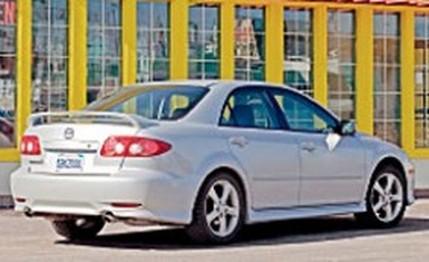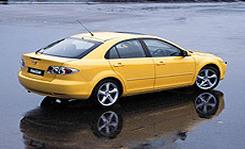 First Drive Review
First Drive Review
Last year in the U.S., Mazda sold 50,997 units of its 626 mid-size sedan. That's a fair number of cars, but chump change when compared with its competitors. Honda enticed 414,718 customers in 2001 to throw down Benjamins on Accords, Toyota bagged 390,449 happy Camry owners, Ford pawned 353,560 Tauruses, and Nissan completed 148,345 Altima transactions. Even Fahrvergnügen showrooms moved 95,028 Passats.
Mazda feels certain the qualities of this new car will result in a bigger slice of the pie. Come this fall, the aged, three-box 626 is history, as is the Millenia. Both will be replaced by a trio of "6s" made up of a four-door sedan, a five-door hatchback, and a five-door wagon. The trio's first arrival is the bread-and-butter sedan, a car that fully measures up to its predecessor and competitors. At 186.8 inches long, the 6 is 0.6 inch shorter than the 626, two-plus inches shorter than the Accord and Camry, yet 1.6 inches longer than the Passat. The 6--at 70.1 inches wide--is 0.8 inch wider than the 626, 0.3 inch narrower than the Altima, and nearly three inches skinnier than the Taurus. Stand the ruler vertically, and the 56.7-inch-high 6 is overshadowed by all but the 626 and the Taurus, which are 1.6 inches and 0.6 inch shorter, respectively.

Although the 6 is similar in size to its competitors, its taut sheetmetal and wheels-stretched-to-the-corners design make it appear more compact. The philosophy of chief designer Iwao Koizumi was "emotion in motion," a three-dimensional sense of athletic movement and form. True enough, the 6 looks athletic. The stance is aggressive, the proportions dynamic, and the silhouette tense.
The front of the car features Mazda's signature five-point grille highlighted by a fat chrome bar on top and a five-inch-wide Mazda logo in the middle. Flanking the grille are cat-eye headlight units. Koizumi wanted a face that was bold and predatory.
The athletic theme is carried over to the sides and rear of the car, where a defined beltline and wheel arches create a vehicle with "some shoulders." The tail end sports flashy clear-lens taillights that house four circular lamps surrounded in chrome, a look similar to the sparkling hind ends on the Lexus IS and Nissan Altima. But Mazda doesn't want to be labeled a copycat in America, so the taillights on U.S.-bound 6s will feature red lenses with four clear-lens inserts protecting the bulbs.
Behind the wheel, the driver is greeted by a well-executed interior brimming with quality. The black, textured dash material looks and feels as if it came out of a BMW. The large chrome-rimmed tachometer and speedometer are easily legible through the three-spoke steering wheel. A titanium-colored center stack houses--in descending order--three round vents contrasted in black; push-pad and rotary-knob audio controls; and three HVAC control knobs. Atop the center stack resides a rectangular digital readout, which displays the stereo and HVAC information. It's all nicely laid out, nicely done.
The sporty seats adjust in four directions, and it's easy to find a comfortable driving position. Front legroom is generous at 42.3 inches--more than that offered by the Accord, Camry, Taurus, and Passat. Moreover, the steering wheel both tilts and telescopes.
Comfort can also be found in the safety features. The front seats feature a new anti-whiplash design, and the pedals deploy away from the driver's feet in the event of a collision. As for inflatables, the 6 will be available with up to six airbags, including dual-stage front airbags, front-seat side airbags, and optional side-curtain airbags.
Of the five engines for the 6, the U.S. market will get two: a 150-hp, 2.3-liter in-line four-cylinder and a 219-hp, 3.0-liter V-6. Members of Mazda's newly designated MZR engine family, both motors are all-aluminum and have four valves per cylinder, chain-driven double overhead camshafts, and variable valve timing.